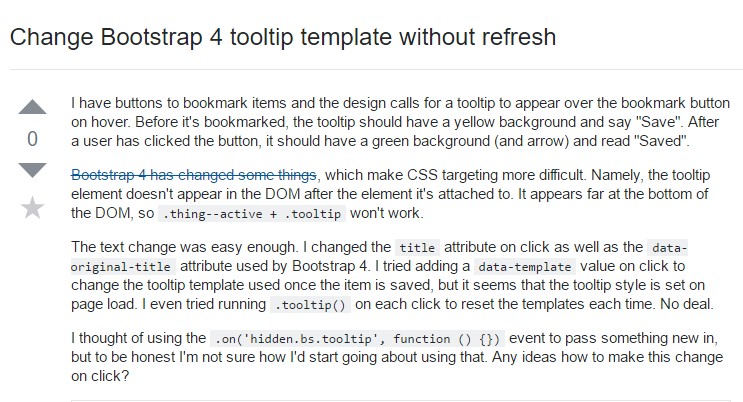Bootstrap Tooltip Class
Intro
In certain situations, specifically on the desktop it is a fantastic idea to have a suggestive callout along with some tips emerging when the visitor places the computer mouse arrow over an element. In this manner we are sure the appropriate information has been actually provided at the proper time and eventually greatly improved the site visitor practical experience and comfort while working with our pages. This particular behaviour is managed with tooltip element which has a trendy and constant to the whole entire framework design appearance in the latest Bootstrap 4 version and it's definitely simple to add and set up them-- why don't we discover how this gets done .
Activities to know while applying the Bootstrap Tooltip Popover:
- Bootstrap Tooltips utilize the 3rd party library Tether for locating . You must involve tether.min.js just before bootstrap.js so as for tooltips to do the job !
- Tooltips are really opt-in for efficiency reasons, so you need to activate them by yourself.
- Bootstrap Tooltip Function with zero-length titles are never featured.
- Specify container: 'body' to stay clear of rendering concerns in extra complicated
components ( just like input groups, button groups, etc).
- Triggering tooltips on hidden elements will not operate.
- Tooltips for .disabled or disabled features must be caused on a wrapper element.
- When caused from website links that span numerous lines, tooltips will be concentered. Employ white-space: nowrap; on your <a>-s to stay clear of this behavior.
Understood all of that? Wonderful, why don't we see precisely how they use some instances.
Exactly how to put into action the Bootstrap Tooltips:
To begin to get use of the tooltips features we need to enable it considering that in Bootstrap these particular elements are not permitted by default and demand an initialization. To do this bring in a basic <script> component somewhere in the end of the <body> tag making certain it has been positioned after the the call to JQuery library given that it works with it for the tooltip initialization. The <script> component should be wrapped around this initialization line of code $(function () $('[data-toggle="tooltip"]').tooltip()) which will switch on the tooltips functionality.
Things that the tooltips truly handle is obtaining what is generally in an element's title = ”” attribute and displaying it within a stylises pop-up element. Tooltips can possibly be employed for different components however are normally very most ideal for <a> and <button> elements considering that these are actually used for the visitor's interaction with the page and are much more likely to be requiring some information concerning what they really perform when hovered by using the mouse-- right prior to the possible selecting them.
Once you have activated the tooltips functionality in order to assign a tooltip to an element you must put in two essential and just one alternative attributes to it. A "tool-tipped" elements need to possess title = “Some text here to get displayed in the tooltip” and data-toggle = “tooltip” attributes-- these are quite sufficient for the tooltip to work out surfacing over the desired element. Assuming that nonetheless you desire to define the placement of the tip message relating to the feature it concerns-- you can easily likewise perform that in the Bootstrap 4 framework with the optional data-placement =” ~ possible values are – top, bottom, left, right ~ “ attribute which in turn values as rather plain. The data-placement default value is top and in the case that this attribute is actually omitted the tooltips appear over the defined element.
The tooltips appeal and activity has continued to be pretty much the same in both the Bootstrap 3 and 4 versions since these truly do function really efficiently-- nothing much more to become required from them.
Representations
One method to boot up all tooltips on a page would most likely be to pick them by their data-toggle attribute:
$(function ()
$('[data-toggle="tooltip"]').tooltip()
)Stationary Demo
Four selections are available: top, right, bottom, and left straightened.

Interactive
Hover above the switches below to view their tooltips.

<button type="button" class="btn btn-secondary" data-toggle="tooltip" data-placement="top" title="Tooltip on top">
Tooltip on top
</button>
<button type="button" class="btn btn-secondary" data-toggle="tooltip" data-placement="right" title="Tooltip on right">
Tooltip on right
</button>
<button type="button" class="btn btn-secondary" data-toggle="tooltip" data-placement="bottom" title="Tooltip on bottom">
Tooltip on bottom
</button>
<button type="button" class="btn btn-secondary" data-toggle="tooltip" data-placement="left" title="Tooltip on left">
Tooltip on left
</button>And with custom-made HTML included:
<button type="button" class="btn btn-secondary" data-toggle="tooltip" data-html="true" title="<em>Tooltip</em> <u>with</u> <b>HTML</b>">
Tooltip with HTML
</button>Handling
The tooltip plugin develops information and markup as needed, and by default places tooltips after their trigger component.
Cause the tooltip by using JavaScript:
$('#example').tooltip(options)Markup
The needed markup for a tooltip is basically only a data attribute and title on the HTML element you desire to have a tooltip. The produced markup of a tooltip is somewhat basic, while it does demand a location (by default, established to top due to the plugin).
Driving tooltips perform for computer keyboard as well as assistive technology users.
You must only add in tooltips to HTML elements that are definitely traditionally keyboard-focusable and interactive ( just like urls or form controls). Though arbitrary HTML components (such as <span>-s) can possibly be produced focusable via adding the tabindex="0" attribute, this will certainly add difficult and most likely irritating tab stops on non-interactive components for keyboard site visitors. On top of that, a large number of assistive technologies presently do not really reveal the tooltip in this particular circumstance.
<!-- HTML to write -->
<a href="#" data-toggle="tooltip" title="Some tooltip text!">Hover over me</a>
<!-- Generated markup by the plugin -->
<div class="tooltip tooltip-top" role="tooltip">
<div class="tooltip-arrow"></div>
<div class="tooltip-inner">
Some tooltip text!
</div>
</div>Opportunities
Alternatives may possibly be successfully pass via data attributes as well as JavaScript. For data attributes, append the option name to data-, like inside data-animation="".
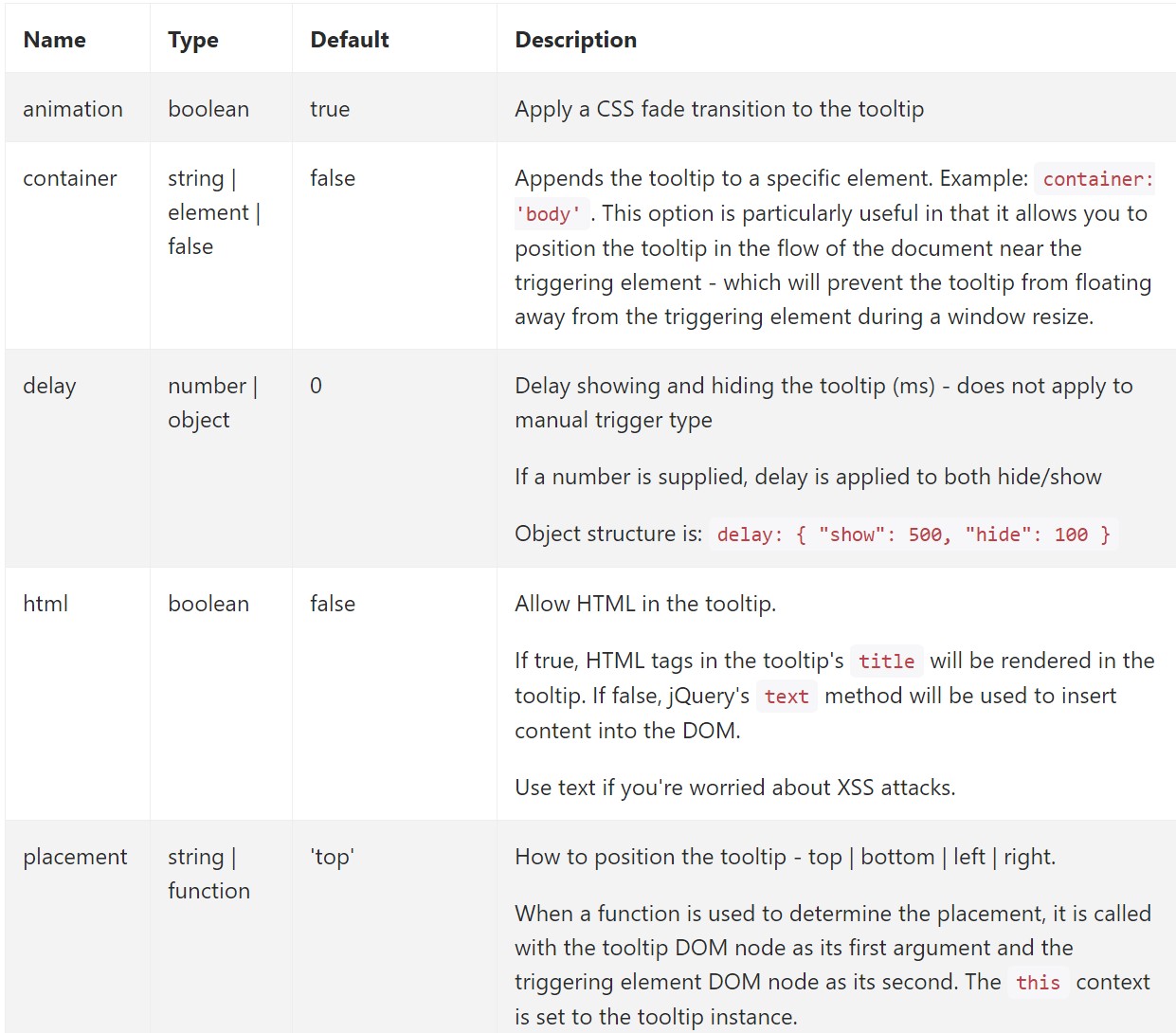
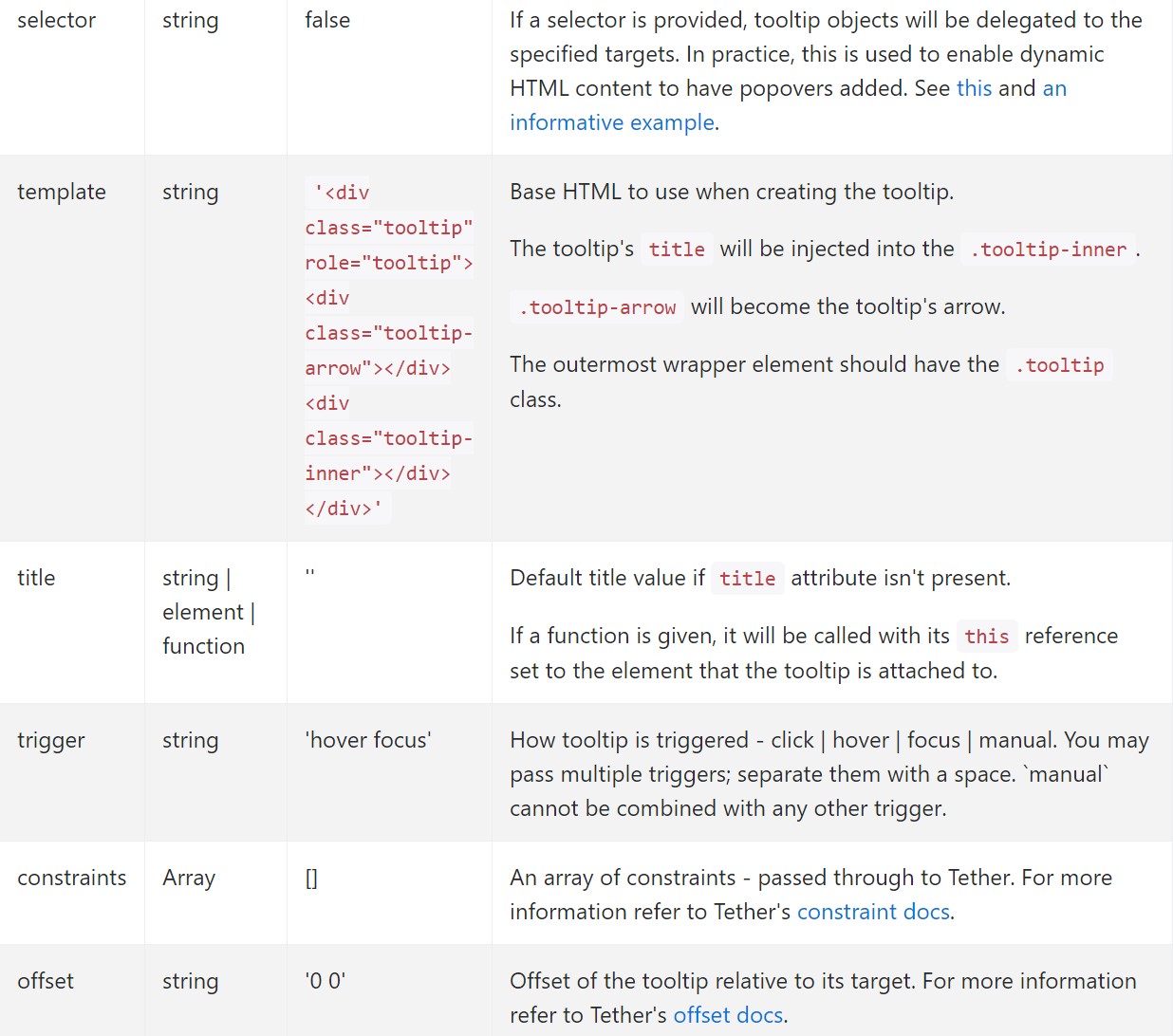
Data attributes for various tooltips
Solutions for special tooltips have the ability to additionally be pointed out through using data attributes, just as clarified above.
Approaches
$().tooltip(options)
Connects a tooltip handler to an element selection.
.tooltip('show')
Exhibits an component's tooltip. Goes back to the customer just before the tooltip has actually been presented ( such as before the shown.bs.tooltip activity takes place). This is kept in mind a "manual" triggering of the tooltip. Tooltips with zero-length titles are certainly never revealed.
$('#element').tooltip('show').tooltip('hide')
Covers an element's tooltip. Goes back to the caller before the tooltip has really been hidden (i.e. before the hidden.bs.tooltip activity occurs). This is looked into a "manual" triggering of the tooltip.
$('#element').tooltip('hide').tooltip('toggle')
Toggles an element's tooltip. Returns to the customer just before the tooltip has actually been revealed or concealed ( such as before the shown.bs.tooltip or else hidden.bs.tooltip occasion takes place). This is considered a "manual" triggering of the tooltip.
$('#element').tooltip('toggle').tooltip('dispose')
Hides and removes an element's tooltip. Tooltips which use delegation ( which in turn are generated applying the selector solution) can not actually be individually destroyed on descendant trigger features.
$('#element').tooltip('dispose')Occasions
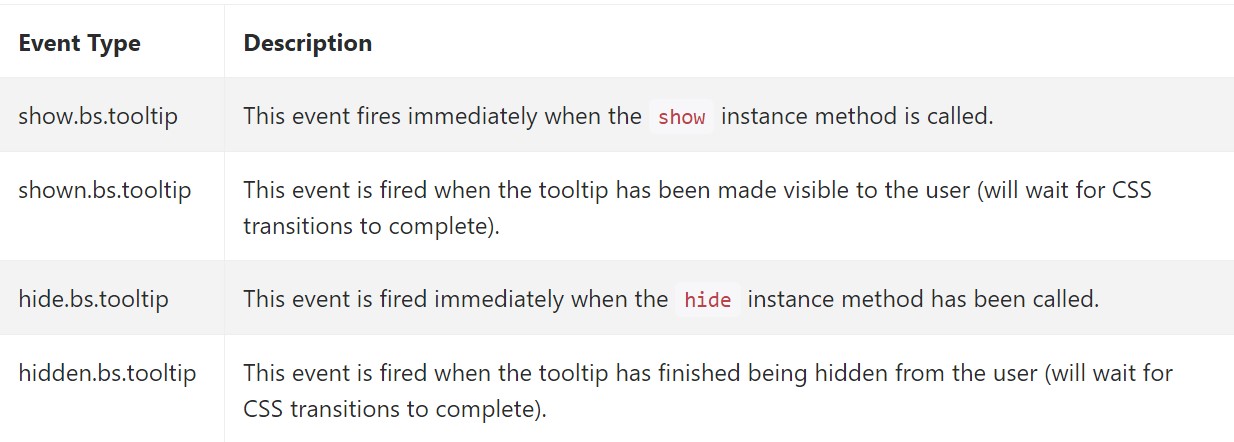
$('#myTooltip').on('hidden.bs.tooltip', function ()
// do something…
)Final thoughts
A detail to take into account right here is the amount of details that goes to be placed into the # attribute and eventually-- the arrangement of the tooltip according to the location of the main feature on a display screen. The tooltips should be precisely this-- short useful suggestions-- installing excessive info might even confuse the site visitor instead assist getting around.
Also in the event that the major feature is extremely close to an edge of the viewport positioning the tooltip beside this very edge might actually trigger the pop-up text to flow out of the viewport and the info inside it to become almost pointless. Therefore, when it concerns tooltips the balance in operating them is essential.
Examine several on-line video information regarding Bootstrap Tooltips:
Related topics:
Bootstrap Tooltips official information

Bootstrap Tooltips information
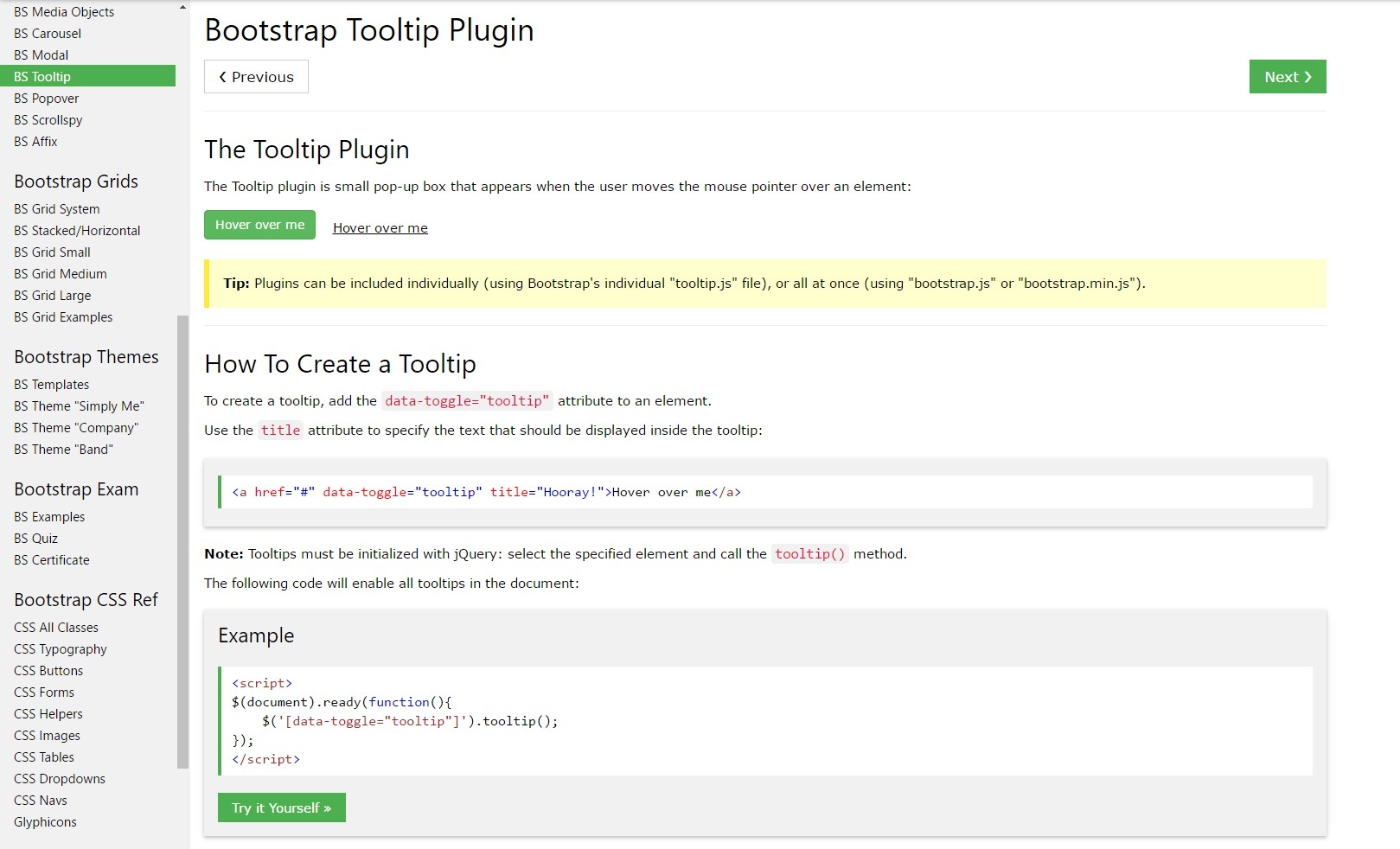
Change Bootstrap 4 Tooltip template without refresh
